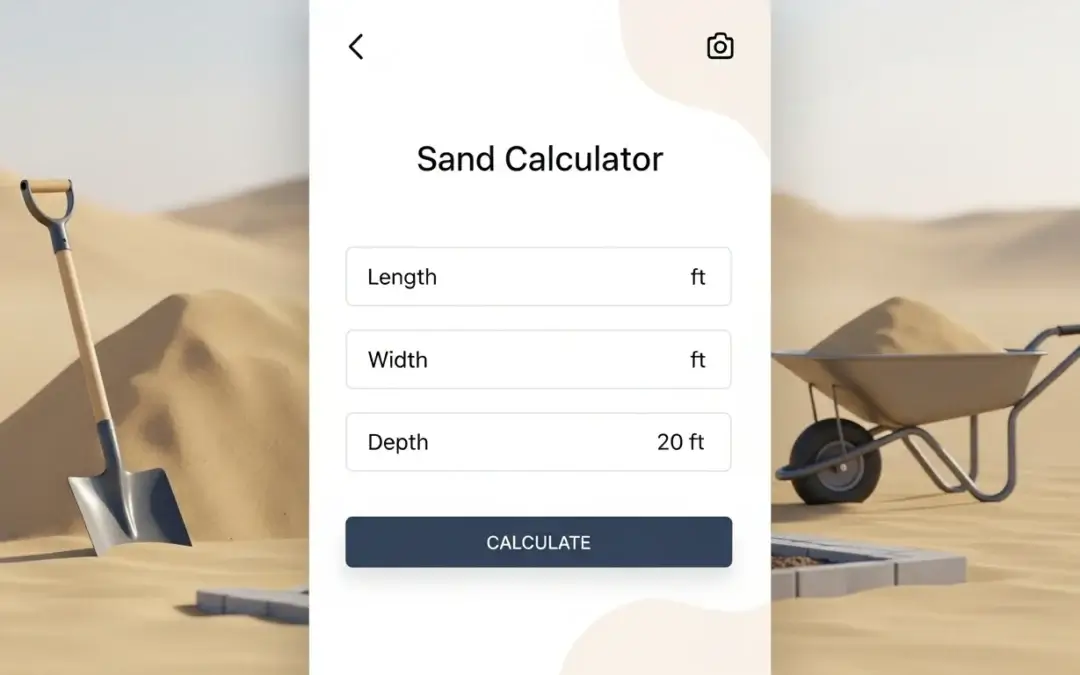Sand Calculator Pro
Calculate the exact amount of sand needed for your construction project
📊 Calculation Results
Calculating…
💰 Cost Calculator
💡 Pro Tips
Sand Calculator: Accurate Measurements for Your Construction & Plumbing Projects
When working on construction, landscaping, or plumbing projects, getting the right amount of sand is crucial. Too little can delay your work, while too much leads to unnecessary costs. A sand calculator helps you estimate the exact quantity needed, saving time and money.
At 907 Heating and Plumbing, we not only provide top-quality plumbing services but also help contractors and DIY enthusiasts with essential tools like a sand calculator for efficient project planning.
Why Use a Sand Calculator?
Sand is a key material in:
- ✓ Concrete mixing (for foundations, slabs)
- ✓ Pipe bedding & backfilling (plumbing & utility lines)
- ✓ Landscaping (patios, walkways, playgrounds)
- ✓ Drainage systems (French drains, septic systems)
A sand calculator eliminates guesswork by providing precise measurements based on:
✔ Project area (length × width × depth)
✔ Type of sand (fine, coarse, masonry, fill sand)
✔ Compaction & settling factors
How Does a Sand Calculator Work?
The calculator uses a simple formula:
Sand Required (Cubic Yards or Tons) = (Length × Width × Depth) / 27 (for cubic yards)
*(Since 27 cubic feet = 1 cubic yard)*
Example Calculation:
If you need sand for a 10 ft × 10 ft area at a 3-inch depth:
- Convert depth to feet: 3 inches = 0.25 ft
- Calculate volume: 10 × 10 × 0.25 = 25 cubic ft
- Convert to cubic yards: 25 / 27 ≈ 0.93 cubic yards
- For tons: Multiply by sand density (~1.3 tons per cubic yard) → 0.93 × 1.3 ≈ 1.2 tons
Types of Sand & Their Uses in Plumbing & Construction
| Type of Sand | Best For |
|---|---|
| Masonry Sand | Brickwork, mortar mixing |
| Concrete Sand | Foundations, slabs |
| Utility Sand | Pipe bedding, backfilling |
| Fill Sand | Leveling, drainage |
Choosing the wrong type can weaken structures or clog drainage systems.
Benefits of Using a Sand Calculator
Prevents Overordering
Reduces material waste & extra costs.
Ensures Stability
Proper sand quantity prevents shifting in plumbing trenches.
Saves Time
No last-minute trips for additional sand.
Improves Project Accuracy
Exact measurements lead to better compaction & longevity.
Common Mistakes When Estimating Sand Manually
❌ Ignoring Compaction – Sand settles, so ordering exact volume leads to shortages.
❌ Wrong Sand Type – Using fine sand where coarse is needed (or vice versa).
❌ Incorrect Depth Calculation – Even a 1-inch error can lead to significant cost differences.
A sand calculator avoids these issues by adjusting for real-world factors.
907 Heating and Plumbing: Your Trusted Partner for Plumbing & Construction Needs
At 907 Heating and Plumbing, we understand that proper material estimation is key to successful projects. Whether you’re:
- ✓ Laying underground pipes
- ✓ Installing a septic system
- ✓ Building a foundation
Our expertise ensures you get the right materials and professional plumbing services for long-lasting results.
FAQs About Sand Calculators
1. How much sand do I need for a plumbing trench?
It depends on pipe size, but generally, 6-12 inches of bedding sand is recommended.
2. Can I use beach sand for construction?
No—it contains salt and organic matter, weakening concrete and causing corrosion.
3. Does a sand calculator work for all types of sand?
Yes, but ensure you input the correct density (e.g., wet vs. dry sand).
4. How accurate are sand calculators?
They provide close estimates, but always order 10% extra for compaction and spillage.
Conclusion: Optimize Your Projects with a Sand Calculator
Using a sand calculator ensures efficiency, cost savings, and structural integrity in plumbing and construction projects. For expert plumbing services, pipe installation, and material guidance, trust 907 Heating and Plumbing to deliver precision and reliability.
Need help with your next project? Contact us today for professional advice and services!

